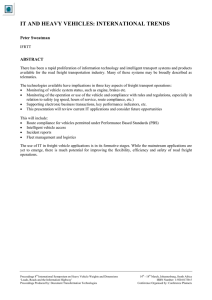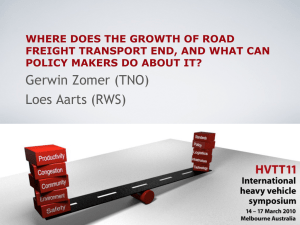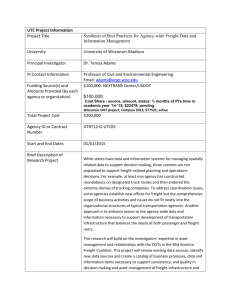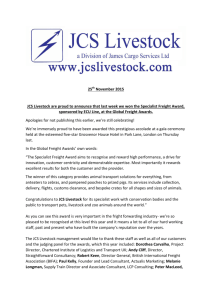1
advertisement
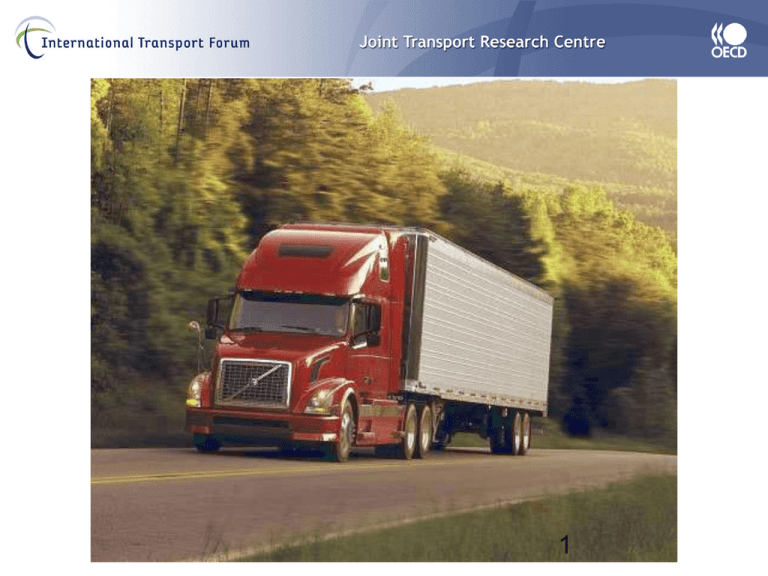
1 Session 6, Plenary 2 programme . Introduction Jorgen Christensen Truck safety Jeff Potter Performance benchmarking Anthony Germanchev Productivity and efficiency John Woodrooffe Break Regulations and compliance Barry Moore Key messages Jorgen Christensen Panel session All the above + Loes Aarts, Matthieu Béreni, Klaus-Peter Glaeser, Bernard Jacob, Paul Nordengen and The OECD/ITF study Moving Freight with Better Trucks HVTT11 International heavy vehicle symposium 14-17 March 2010, Melbourne, Australia Introduction The Limits, Scope and Context of the Study Jorgen Christensen Counsellor to OECD/ITF Joint Transport Research Centre OECD Analyses of Heavy Vehicle issues Impacts of Heavy Freight Vehicles [1983] Dynamic Loading of Pavements [1992] Dynamic Interaction between Vehicles and Infrastructure Experiment (DIVINE), Technical Report, [1998] Dynamic Interaction between Vehicles and Infrastructure Experiment (DIVINE), Policy Implications, [1999] Performance-based Standards for the Road Sector [2005] Why this project? Increasing road freight transport on capacity-limited infrastructure. “Massing-out” of loads in fast growing freight markets. Urgent need to increase efficiency of freight transport. DIVINE project showed potential for heavier loads on “road-friendly” trucks. Implications of technological development for truck productivity and safety. Improving truck compliance with rules and regulations. Conditions necessary for obtaining added societal value from larger road freight vehicles. 5 Membership Australia (4) Belgium(1) Canada (2) Czech Rep. (1) Denmark (1) EU-Commission (1) France (2) Germany (1) Mexico (1) Netherlands (2) Poland (2) Russia (1) Republic of South Africa(1) Sweden (1) UK (1) USA (2) JTRC Secretariat (2) The ”HVTT11-party” Loes Aarts, RWS, The Netherlands Matthieu Beréni, SETRA, France Jorgen Christensen, RTR Facilitation, Denmark, for OECD/ITF Joint Transport Research Centre Anthony Germanchev, ARRB, Australia Klaus-Peter Glaeser Bernard Jacob, LCPC, France Barry Moore, OneMooreConsultancy, Australia Paul Nordengen,CSIR, South Africa Jeff Potter, NTC, Australia John Woodrooffe, UMTRI, United States The purpose of the study is to provide insights into heavy road transport to facilitate development of policies to improve its productivity and social and environmental sustainability; document the current situation and identify realistic short-tomedium term opportunities for improving performance; examine how the safety and environmental performance and productivity of this industry can benefit from new technologies; highlight how a modern regulatory framework can improve compliance, provide for better safety and environmental performance and deter operators from gaining competitive advantages through non-compliance. Factors driving road transport Door-to-door collection and delivery, shorter transport times and more flexibility than any other surface transport mode. Rapid expansion of road networks, largely to provide for cars. By 1995 largely liberalized with reductions in transport prices. Jurisdictional borders softened in many economic regions, leading to greater efficiency for long-distance transport. Technological improvements have further helped to increase efficiency, and so the supply of transport services has improved. Globalisation increases distances to the market and demand has concentrated on links used for moving containers to and from ports. Falling transport costs have driven logistics changes with stock centralization in fewer, larger warehouses and longer transports. Vehicles and time perspective considered Much of the discussion and analysis includes all “heavy freight vehicles” but main findings focus on “trucks”. “Trucks” are “heavy freight vehicles” with a permissible mass greater than 12 t and trailers with a mass greater than 10 t (UNECE Classes N3 and O4 or Classes 7 and 8 trucks in North America). “Heavy freight vehicles” with a permissible maximum mass below 12 t, typically used in urban areas, are not considered, although they present many of the same policy challenges. The report is aimed at the situation in the developed, industrialised economies of the OECD/ITF member countries, although many observations apply also in countries with developing economies. The time perspective of the report is the short to medium term future, i.e. the 10 years to 2020 GDP and Rail and Road Freight and Passenger Transport Growth in ITF Member Countries (GDP in 2005 Euros - 1995=100) Source ITF, excluding Canada, Liechtenstein, Malta and Montenegro 11 OECD/ITF country growth in domestic freight transport Volume growth for domestic freight transport by road and all modes between 1995 and 2005 Evolution between 1995 and 2005 of the modal share for freight transport Modal distribution of surface freight transport 2005 100% 90% 80% 70% 60% Pipeline 50% IWW+sea 40% Rail 30% Road 20% 10% 0% RUS CAN USA AUS EU-25 JAP Projections for volume of freight transport in the EU-25 by 2030 billion tonne-km Crude Oil Prices 1987-2009 Fuel costs, Road taxes and Operating costs for European road freight transport in 2003 (in euros/vehicle-kilometre) Price sensitivity of road freight demand and its crossmodal implications Few studies of price sensitivity of road freight demand exist. Responses range from near zero to 80 %. Very large variations in road-rail cross-elasticities. Differences between European, Japanese, North American and Australian markets are pronounced and results of these kinds of study are not easily transferable. More basic research on this topic is badly needed. Relevant to environmental and safety impacts of HCVs. Thank you for the attention 20 . Introduction Jorgen Christensen Truck safety Jeff Potter Performance Benchmarking Anthony Germanchev Productivity and efficiency John Woodrooffe Break Regulations and Compliance Barry Moore Key messages Jorgen Christensen Panel session All the above and: Loes Aarts, Matthieu Béreni, Klaus-Peter Glaeser, Bernard Jacob and Paul Nordengen

